Brazil
 Brazil grows roughly a third of the world's coffee. Much of the specialty from brazil is known by the name of the port through which it is shipped, Santos. Bourbon Santos and Brazil Cerrado are widely used as a base for quality espresso blends. Brazilian coffee is commonly dry-processed.
|
Colombia
 Colombia typically produces about 1/10th, or more, of the worlds coffee. Colombia now ranks third after Vietnam and Brazil in production of coffee beans. The bulk of Colombian coffee, such as Colombian Supremo, is high quality and Colombia has marketed its product well via the character Juan Valdez. Colombian coffees are processed using the wet method. Colombian coffee is grown along three northern Andes mountain ranges which trisect Colombia from north to south. Colombian coffees are typically mild and balanced with good body and flavor.
|
Costa Rica
 Costa Rica has excellent coffee growing conditions and certainly produces some of the best coffees in the world. High grown coffees from the mountains of Costa Rica are typically bright, crisp, and clean with good body and a fruity acidity. Notable coffee growing regions include Tarrazu, Tres Rios, Herediá, and Alajuela.
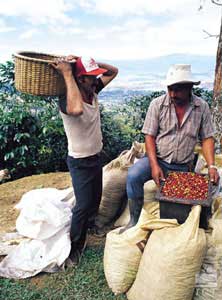
|
Dominican Republic
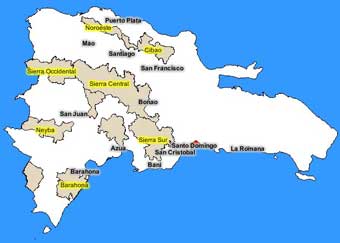 Dominican Republic has various microclimates that produce coffee beans with distinct physical and taste characteristics. The government of Dominican Republic established seven official coffee-growing regions: Barahona, Cibao, Neyba, Noroeste, Sierra Central, Sierra Occidental, and Sierra Sur.
|
El Salvador
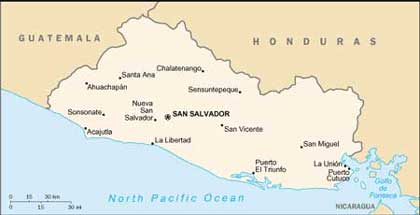 Coffees from El Salvador have mostly been used for blending due to their sweetness, gentle acidity, and balance. Although El Salvador produces excellent coffees, political instability has prevented a consistent supply. Recently, El Salvador has been gaining in recognition for its premium single origin coffees. El Salvador shares a border with Honduras and Guatemala.
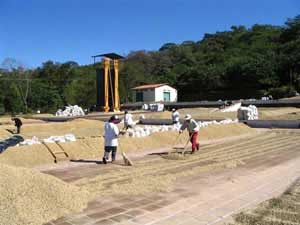
|
Ethiopia
 Ethiopia is the birthplace of the Arabica tree, and wild coffee cherries are still harvested by tribes people in its mountains. In Eastern Ethiopia, coffee trees are grown at elevations between 5,000 and 6,000 feet on small plots and farms. These coffees may be called Longberry Harrar (large bean), Shortberry Harrar (smaller bean) or Mocha Harrar (peaberry or single bean). They are all cultivated simply, processed by the traditional dry method, and are no doubt organic. Ethiopian Harrar is characterized by winy and blueberry undertones, with good body and acidity. Eastern Ethiopia produces a washed coffee called Ghimbi, or Gimbi, that has the winy undertones of Harrar, but can be richer, more balanced, and has a heavier body and longer finish. Southern Ethiopia produces washed coffees with fruity acidity and intense aromas. These coffees are known by the names of the districts in which they are produced, such as Sidamo, or by terms like Ethiopian Fancies or Ethiopian Estate Grown. The most famous of these coffees is Yirgacheffe, which has a pleasant fruity acidity and elegant body.

|
Guatemala
 Some of the worlds finest specialty coffee is produced in the central Highlands of Guatemala. The most famous regional marketing names for Guatemala coffees are: Antigua, Coban, and Huehuetenango. High quality Guatemalan coffees are produced using the wet-process method, and typically have spicy or chocolatey acidity and medium body. Guatemalan coffee is often marketed by grade, with the highest grade being strictly hard bean (SHB), which indicates coffees grown at 4,500 feet or above. A secondary grade is hard bean (HB), designating coffees grown between 4,000 and 4,500 feet. These designations reflect the fact that coffee beans grown at higher elevations tend to be denser and harder than coffee beans grown at lower elevations.

|
Honduras
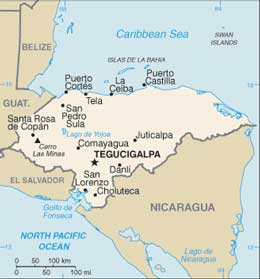 Honduras shares a border with Guatemala and Nicaragua. The finest Honduran coffees are sweet, mild, and full bodied.
|
India
 Coffees produced in India have more in common with Indonesian coffees than with coffees from Africa or the Arabian peninsula. Good Indian coffees are grown in the states of Karnatka (formerly Mysore), Kerala, and Tamilnadu (formerly Madras). In good years these coffees may contain acidity typical of Guatemalan coffee, and the full body of a good Javanese coffee. These coffees are known for their unique spicy flavors of nutmeg, clove, cardamom, and pepper. India also produces monsoon coffees, in which the green beans have been exposed to moisture-laden monsoon winds blowing through open warehouses during India's rainy season. This process reduces acidity and enhances sweetness, making them similar to Indonesian aged coffees.
|
Indonesia
 Indonesia is the world's fourth largest producer of coffee. However, a majority of the crop is Robusta, and the amount of quality beans available for the specialty coffee industry is limited. Even though they are a somewhat small percentage of total production, Arabica coffees from this region are considered some of the best in the world, and are prized for their richness, full body, long finish, earthiness and gentle acidity.
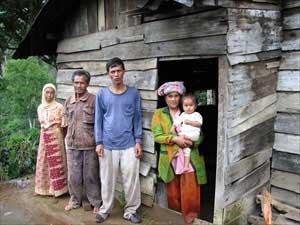
|
Jamaica
 Jamaica is home to one of the world's most controversial coffees, Jamaican Blue Mountain. The best Blue Mountain coffee is characterized by a nutty aroma, bright acidity and a unique beef-bouillon like flavor. Jamaican High Mountain is a term that applies to coffees of lesser quality grown at a low altitudes compared to Jamaican Blue Mountain. Jamaica High Mountain and Jamaica Blue Mountain coffees are produced by the wet-process.
|
Kenya
 Kenya has a reputation for exporting high quality coffee beans. Most coffees in Kenya are cultivated on very small farms, and the growers are rewarded with high prices for high quality beans. The main growing region in Kenya extends from south of Mt. Kenya to near the capital of Nairobi. Coffee from Kenya is generally wet-processed and classified by bean size, with Grade AA signifying the largest beans, followed by grades A and B. Coffee from a single Kenya coffee estate, called Estate Kenya, can cost twice as much as regular Kenya AA. Estate Kenyas rank with the finest coffees in the world and are known for having tremendous body, astounding winy acidity and black-current flavor and aroma.
|
Mexico
 Mexico produces large quantities of coffee often used for dark roasts and blending. The state of Vera Cruz produces mostly average coffees in its low laying regions, but in its mountains near the city of Coatepec a specialty coffee called Altura Coatepec is produced. These high grown, or altura, coffees tend to be light bodied and nutty, with a chocolatey brightness. Altura Orizaba and Altura Huatusco are other fine coffees produced in Vera Cruz. The state of Oaxaca in the central mountains also produces very good coffees, referred to as either Mexico Oaxaca or Oaxaca Pluma. Chiapas, near the Guatemalan border, produces some impressive coffees as well. Coffees from Mexico are wet processed.
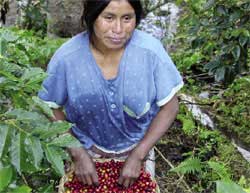
|
Nicaragua
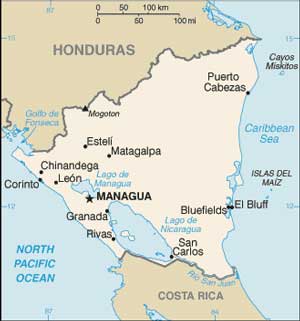 Nicaragua is located in Central America and shares a border with Honduras and Costa Rica. Very fine specialty coffee is produced in the mountains of Nicaragua. The most famous regional marketing names are: Matagalpa, Jinotega, and Segovia. The highest quality Nicaragua coffees have rich flavor, mild fruity brightness, and full body.
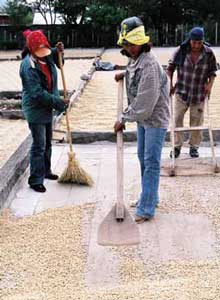
|
Papua New Guinea
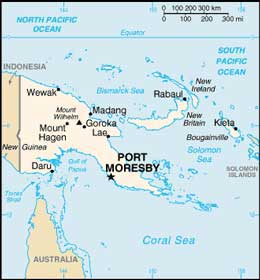 Papua New Guinea (PNG) Coffee is cultivated on small plantations in the mountain highlands, and is processed using the wet method. Two of New Guinea's most famous coffees are Sigri and Arona. PNG coffee is typically well-balanced with a fruity aroma and earthy body, and generally has less acidity, aroma, and body, than other fine Indonesian coffees.
|
Peru
 Peru generally produces mild coffee used mostly for blending, French roasts, and as a base for flavored-coffee. Good Peruvian coffee can be found high in the Andes in the Chanchamayo and Urubamba Valleys. Northern Peru has gained a reputation for producing good quality, certified organic coffees.
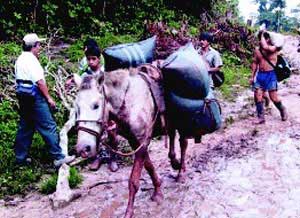
|
Rwanda
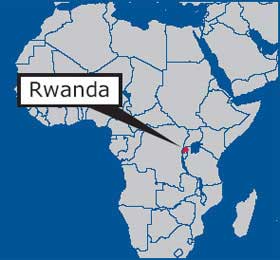 While a relatively small contributor to the world coffee market, Rwanda coffee is big business for it's nearly 500,000 coffee grower families. Rwanda produces some excellent coffees with qualities commonly found in other east African nations such as Kenya and Zimbabwe. Coffee in Rwanda is generally processed by the wet method.
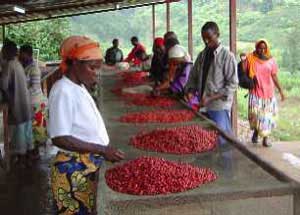
|
Tanzania
 Most Tanzanian coffees are grown near the border of Kenya on the slopes of Mt. Kilimanjaro, and are sometimes referred to as Kilimanjaro, Moshi or Arusha. Other coffees are grown further south between Lake Tanganyika and Lake Nyasa, and are usually called Mbeya, after one of the region's cities or Pare, a market name. All coffees are wet-processed and graded by bean size, with the highest grade being AA, then A and B. Tanzanian coffees are characterized by a winy acidity, medium to full body, and deep richness. Tanzanian Peaberries are often separated from flat beans and sold at a premium for their enhanced flavor characteristics.
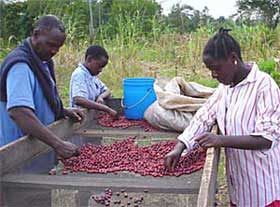
|
Uganda
 Most of the coffee produced in Uganda is Robusta, and is used for instant coffee. Uganda does produce one fine Arabica called either Bugishu or Bugisu, and it is grown on the western slopes of Mt. Elgon on the Kenyan border. This coffee is winy in its acidity, and similar to Kenyan coffee in flavor, though lighter in body.
|
Vietnam
 Vietnam has greatly increased production of coffee in recent years and now produces more coffee than Colombia. Although Vietnam ranks second in the world for total volume of coffee exported, it does not yield a significant crop of high grade specialty coffee.
|
Yemen
 Coffee originated in Ethiopia and was cultivated and processed commercially in neighboring Yemen over a thousand years ago. Arabian Mocha, grown in the northern mountains of Yemen, is one of the oldest and most traditional coffees in the world. It is also one of the finest. Yemen Mocha has been cultivated and processed in the same way for centuries, grown on mountain terraces and dried by the sun. No chemicals are used in Yemeni coffee production, and it is no doubt organic. Two famous market names for this coffee are Mattari and Sanani. Sanani mochas have a wild, fruity acidity, while Mattari mochas are known for their full body and chocolatey undertones.
|
Zimbabwe
 Coffee in Zimbabwe is grown on medium-sized farms and is roughly comparable to coffee from Kenya, although Zimbabwe coffee typically has slightly less acidity. The highest quality coffee in Zimbabwe is grown in the Chipinga, or Chipinge, region. Zimbabwe AA Plus Salimba, is a historically excellent coffee from the Chipinga region of Zimbabwe. The finest coffees from Zimbabwe are balanced with rich flavor, moderate acidity, and good aftertaste.
|
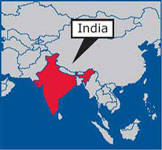
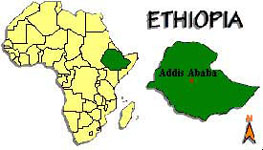
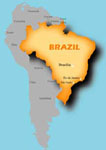

 Brazil grows roughly a third of the world's coffee. Much of the specialty from brazil is known by the name of the port through which it is shipped, Santos. Bourbon Santos and Brazil Cerrado are widely used as a base for quality espresso blends. Brazilian coffee is commonly dry-processed.
Brazil grows roughly a third of the world's coffee. Much of the specialty from brazil is known by the name of the port through which it is shipped, Santos. Bourbon Santos and Brazil Cerrado are widely used as a base for quality espresso blends. Brazilian coffee is commonly dry-processed.
 Colombia typically produces about 1/10th, or more, of the worlds coffee. Colombia now ranks third after Vietnam and Brazil in production of coffee beans. The bulk of Colombian coffee, such as
Colombia typically produces about 1/10th, or more, of the worlds coffee. Colombia now ranks third after Vietnam and Brazil in production of coffee beans. The bulk of Colombian coffee, such as  Costa Rica has excellent coffee growing conditions and certainly produces some of the best coffees in the world. High grown coffees from the mountains of Costa Rica are typically bright, crisp, and clean with good body and a fruity acidity. Notable coffee growing regions include
Costa Rica has excellent coffee growing conditions and certainly produces some of the best coffees in the world. High grown coffees from the mountains of Costa Rica are typically bright, crisp, and clean with good body and a fruity acidity. Notable coffee growing regions include 
 Dominican Republic has various microclimates that produce coffee beans with distinct physical and taste characteristics. The government of Dominican Republic established seven official coffee-growing regions: Barahona, Cibao, Neyba, Noroeste, Sierra Central, Sierra Occidental, and Sierra Sur.
Dominican Republic has various microclimates that produce coffee beans with distinct physical and taste characteristics. The government of Dominican Republic established seven official coffee-growing regions: Barahona, Cibao, Neyba, Noroeste, Sierra Central, Sierra Occidental, and Sierra Sur.
 Coffees from El Salvador have mostly been used for blending due to their sweetness, gentle acidity, and balance. Although El Salvador produces excellent coffees, political instability has prevented a consistent supply. Recently, El Salvador has been gaining in recognition for its premium single origin coffees. El Salvador shares a border with Honduras and Guatemala.
Coffees from El Salvador have mostly been used for blending due to their sweetness, gentle acidity, and balance. Although El Salvador produces excellent coffees, political instability has prevented a consistent supply. Recently, El Salvador has been gaining in recognition for its premium single origin coffees. El Salvador shares a border with Honduras and Guatemala.

 Ethiopia is the birthplace of the Arabica tree, and wild coffee cherries are still harvested by tribes people in its mountains. In Eastern Ethiopia, coffee trees are grown at elevations between 5,000 and 6,000 feet on small plots and farms. These coffees may be called Longberry Harrar (large bean), Shortberry Harrar (smaller bean) or Mocha Harrar (peaberry or single bean). They are all cultivated simply, processed by the traditional dry method, and are no doubt organic. Ethiopian Harrar is characterized by winy and blueberry undertones, with good body and acidity. Eastern Ethiopia produces a washed coffee called Ghimbi, or Gimbi, that has the winy undertones of Harrar, but can be richer, more balanced, and has a heavier body and longer finish. Southern Ethiopia produces washed coffees with fruity acidity and intense aromas. These coffees are known by the names of the districts in which they are produced, such as Sidamo, or by terms like Ethiopian Fancies or Ethiopian Estate Grown. The most famous of these coffees is Yirgacheffe, which has a pleasant fruity acidity and elegant body.
Ethiopia is the birthplace of the Arabica tree, and wild coffee cherries are still harvested by tribes people in its mountains. In Eastern Ethiopia, coffee trees are grown at elevations between 5,000 and 6,000 feet on small plots and farms. These coffees may be called Longberry Harrar (large bean), Shortberry Harrar (smaller bean) or Mocha Harrar (peaberry or single bean). They are all cultivated simply, processed by the traditional dry method, and are no doubt organic. Ethiopian Harrar is characterized by winy and blueberry undertones, with good body and acidity. Eastern Ethiopia produces a washed coffee called Ghimbi, or Gimbi, that has the winy undertones of Harrar, but can be richer, more balanced, and has a heavier body and longer finish. Southern Ethiopia produces washed coffees with fruity acidity and intense aromas. These coffees are known by the names of the districts in which they are produced, such as Sidamo, or by terms like Ethiopian Fancies or Ethiopian Estate Grown. The most famous of these coffees is Yirgacheffe, which has a pleasant fruity acidity and elegant body.

 Some of the worlds finest specialty coffee is produced in the central Highlands of Guatemala. The most famous regional marketing names for Guatemala coffees are:
Some of the worlds finest specialty coffee is produced in the central Highlands of Guatemala. The most famous regional marketing names for Guatemala coffees are: 
 Honduras shares a border with Guatemala and Nicaragua. The finest Honduran coffees are sweet, mild, and full bodied.
Honduras shares a border with Guatemala and Nicaragua. The finest Honduran coffees are sweet, mild, and full bodied.
 Coffees produced in India have more in common with Indonesian coffees than with coffees from Africa or the Arabian peninsula. Good Indian coffees are grown in the states of Karnatka (formerly Mysore), Kerala, and Tamilnadu (formerly Madras). In good years these coffees may contain acidity typical of Guatemalan coffee, and the full body of a good Javanese coffee. These coffees are known for their unique spicy flavors of nutmeg, clove, cardamom, and pepper. India also produces monsoon coffees, in which the green beans have been exposed to moisture-laden monsoon winds blowing through open warehouses during India's rainy season. This process reduces acidity and enhances sweetness, making them similar to Indonesian aged coffees.
Coffees produced in India have more in common with Indonesian coffees than with coffees from Africa or the Arabian peninsula. Good Indian coffees are grown in the states of Karnatka (formerly Mysore), Kerala, and Tamilnadu (formerly Madras). In good years these coffees may contain acidity typical of Guatemalan coffee, and the full body of a good Javanese coffee. These coffees are known for their unique spicy flavors of nutmeg, clove, cardamom, and pepper. India also produces monsoon coffees, in which the green beans have been exposed to moisture-laden monsoon winds blowing through open warehouses during India's rainy season. This process reduces acidity and enhances sweetness, making them similar to Indonesian aged coffees.
 Indonesia is the world's fourth largest producer of coffee. However, a majority of the crop is Robusta, and the amount of quality beans available for the specialty coffee industry is limited. Even though they are a somewhat small percentage of total production, Arabica coffees from this region are considered some of the best in the world, and are prized for their richness, full body, long finish, earthiness and gentle acidity.
Indonesia is the world's fourth largest producer of coffee. However, a majority of the crop is Robusta, and the amount of quality beans available for the specialty coffee industry is limited. Even though they are a somewhat small percentage of total production, Arabica coffees from this region are considered some of the best in the world, and are prized for their richness, full body, long finish, earthiness and gentle acidity.

 Jamaica is home to one of the world's most controversial coffees, Jamaican Blue Mountain. The best Blue Mountain coffee is characterized by a nutty aroma, bright acidity and a unique beef-bouillon like flavor. Jamaican High Mountain is a term that applies to coffees of lesser quality grown at a low altitudes compared to Jamaican Blue Mountain. Jamaica High Mountain and Jamaica Blue Mountain coffees are produced by the wet-process.
Jamaica is home to one of the world's most controversial coffees, Jamaican Blue Mountain. The best Blue Mountain coffee is characterized by a nutty aroma, bright acidity and a unique beef-bouillon like flavor. Jamaican High Mountain is a term that applies to coffees of lesser quality grown at a low altitudes compared to Jamaican Blue Mountain. Jamaica High Mountain and Jamaica Blue Mountain coffees are produced by the wet-process.
 Kenya has a reputation for exporting high quality coffee beans. Most coffees in Kenya are cultivated on very small farms, and the growers are rewarded with high prices for high quality beans. The main growing region in Kenya extends from south of Mt. Kenya to near the capital of Nairobi. Coffee from Kenya is generally wet-processed and classified by bean size, with Grade AA signifying the largest beans, followed by grades A and B. Coffee from a single Kenya coffee estate, called Estate Kenya, can cost twice as much as regular Kenya AA. Estate Kenyas rank with the finest coffees in the world and are known for having tremendous body, astounding winy acidity and black-current flavor and aroma.
Kenya has a reputation for exporting high quality coffee beans. Most coffees in Kenya are cultivated on very small farms, and the growers are rewarded with high prices for high quality beans. The main growing region in Kenya extends from south of Mt. Kenya to near the capital of Nairobi. Coffee from Kenya is generally wet-processed and classified by bean size, with Grade AA signifying the largest beans, followed by grades A and B. Coffee from a single Kenya coffee estate, called Estate Kenya, can cost twice as much as regular Kenya AA. Estate Kenyas rank with the finest coffees in the world and are known for having tremendous body, astounding winy acidity and black-current flavor and aroma.
 Mexico produces large quantities of coffee often used for dark roasts and blending. The state of Vera Cruz produces mostly average coffees in its low laying regions, but in its mountains near the city of Coatepec a specialty coffee called Altura Coatepec is produced. These high grown, or altura, coffees tend to be light bodied and nutty, with a chocolatey brightness. Altura Orizaba and Altura Huatusco are other fine coffees produced in Vera Cruz. The state of Oaxaca in the central mountains also produces very good coffees, referred to as either Mexico Oaxaca or Oaxaca Pluma. Chiapas, near the Guatemalan border, produces some impressive coffees as well. Coffees from Mexico are wet processed.
Mexico produces large quantities of coffee often used for dark roasts and blending. The state of Vera Cruz produces mostly average coffees in its low laying regions, but in its mountains near the city of Coatepec a specialty coffee called Altura Coatepec is produced. These high grown, or altura, coffees tend to be light bodied and nutty, with a chocolatey brightness. Altura Orizaba and Altura Huatusco are other fine coffees produced in Vera Cruz. The state of Oaxaca in the central mountains also produces very good coffees, referred to as either Mexico Oaxaca or Oaxaca Pluma. Chiapas, near the Guatemalan border, produces some impressive coffees as well. Coffees from Mexico are wet processed.

 Nicaragua is located in Central America and shares a border with Honduras and Costa Rica. Very fine specialty coffee is produced in the mountains of Nicaragua. The most famous regional marketing names are: Matagalpa, Jinotega, and Segovia. The highest quality Nicaragua coffees have rich flavor, mild fruity brightness, and full body.
Nicaragua is located in Central America and shares a border with Honduras and Costa Rica. Very fine specialty coffee is produced in the mountains of Nicaragua. The most famous regional marketing names are: Matagalpa, Jinotega, and Segovia. The highest quality Nicaragua coffees have rich flavor, mild fruity brightness, and full body.

 Papua New Guinea (PNG) Coffee is cultivated on small plantations in the mountain highlands, and is processed using the wet method. Two of New Guinea's most famous coffees are Sigri and Arona. PNG coffee is typically well-balanced with a fruity aroma and earthy body, and generally has less acidity, aroma, and body, than other fine Indonesian coffees.
Papua New Guinea (PNG) Coffee is cultivated on small plantations in the mountain highlands, and is processed using the wet method. Two of New Guinea's most famous coffees are Sigri and Arona. PNG coffee is typically well-balanced with a fruity aroma and earthy body, and generally has less acidity, aroma, and body, than other fine Indonesian coffees.
 Peru generally produces mild coffee used mostly for blending, French roasts, and as a base for flavored-coffee. Good Peruvian coffee can be found high in the Andes in the Chanchamayo and Urubamba Valleys. Northern Peru has gained a reputation for producing good quality, certified organic coffees.
Peru generally produces mild coffee used mostly for blending, French roasts, and as a base for flavored-coffee. Good Peruvian coffee can be found high in the Andes in the Chanchamayo and Urubamba Valleys. Northern Peru has gained a reputation for producing good quality, certified organic coffees.

 While a relatively small contributor to the world coffee market, Rwanda coffee is big business for it's nearly 500,000 coffee grower families. Rwanda produces some excellent coffees with qualities commonly found in other east African nations such as Kenya and Zimbabwe. Coffee in Rwanda is generally processed by the wet method.
While a relatively small contributor to the world coffee market, Rwanda coffee is big business for it's nearly 500,000 coffee grower families. Rwanda produces some excellent coffees with qualities commonly found in other east African nations such as Kenya and Zimbabwe. Coffee in Rwanda is generally processed by the wet method.

 Most Tanzanian coffees are grown near the border of Kenya on the slopes of Mt. Kilimanjaro, and are sometimes referred to as Kilimanjaro, Moshi or Arusha. Other coffees are grown further south between Lake Tanganyika and Lake Nyasa, and are usually called Mbeya, after one of the region's cities or Pare, a market name. All coffees are wet-processed and graded by bean size, with the highest grade being AA, then A and B. Tanzanian coffees are characterized by a winy acidity, medium to full body, and deep richness.
Most Tanzanian coffees are grown near the border of Kenya on the slopes of Mt. Kilimanjaro, and are sometimes referred to as Kilimanjaro, Moshi or Arusha. Other coffees are grown further south between Lake Tanganyika and Lake Nyasa, and are usually called Mbeya, after one of the region's cities or Pare, a market name. All coffees are wet-processed and graded by bean size, with the highest grade being AA, then A and B. Tanzanian coffees are characterized by a winy acidity, medium to full body, and deep richness. 
 Most of the coffee produced in Uganda is Robusta, and is used for instant coffee. Uganda does produce one fine Arabica called either Bugishu or Bugisu, and it is grown on the western slopes of Mt. Elgon on the Kenyan border. This coffee is winy in its acidity, and similar to Kenyan coffee in flavor, though lighter in body.
Most of the coffee produced in Uganda is Robusta, and is used for instant coffee. Uganda does produce one fine Arabica called either Bugishu or Bugisu, and it is grown on the western slopes of Mt. Elgon on the Kenyan border. This coffee is winy in its acidity, and similar to Kenyan coffee in flavor, though lighter in body.
 Vietnam has greatly increased production of coffee in recent years and now produces more coffee than Colombia. Although Vietnam ranks second in the world for total volume of coffee exported, it does not yield a significant crop of high grade specialty coffee.
Vietnam has greatly increased production of coffee in recent years and now produces more coffee than Colombia. Although Vietnam ranks second in the world for total volume of coffee exported, it does not yield a significant crop of high grade specialty coffee.
 Coffee originated in Ethiopia and was cultivated and processed commercially in neighboring Yemen over a thousand years ago. Arabian Mocha, grown in the northern mountains of Yemen, is one of the oldest and most traditional coffees in the world. It is also one of the finest. Yemen Mocha has been cultivated and processed in the same way for centuries, grown on mountain terraces and dried by the sun. No chemicals are used in Yemeni coffee production, and it is no doubt organic. Two famous market names for this coffee are Mattari and Sanani. Sanani mochas have a wild, fruity acidity, while Mattari mochas are known for their full body and chocolatey undertones.
Coffee originated in Ethiopia and was cultivated and processed commercially in neighboring Yemen over a thousand years ago. Arabian Mocha, grown in the northern mountains of Yemen, is one of the oldest and most traditional coffees in the world. It is also one of the finest. Yemen Mocha has been cultivated and processed in the same way for centuries, grown on mountain terraces and dried by the sun. No chemicals are used in Yemeni coffee production, and it is no doubt organic. Two famous market names for this coffee are Mattari and Sanani. Sanani mochas have a wild, fruity acidity, while Mattari mochas are known for their full body and chocolatey undertones.
 Coffee in Zimbabwe is grown on medium-sized farms and is roughly comparable to coffee from Kenya, although Zimbabwe coffee typically has slightly less acidity. The highest quality coffee in Zimbabwe is grown in the Chipinga, or Chipinge, region. Zimbabwe AA Plus Salimba, is a historically excellent coffee from the Chipinga region of Zimbabwe. The finest coffees from Zimbabwe are balanced with rich flavor, moderate acidity, and good aftertaste.
Coffee in Zimbabwe is grown on medium-sized farms and is roughly comparable to coffee from Kenya, although Zimbabwe coffee typically has slightly less acidity. The highest quality coffee in Zimbabwe is grown in the Chipinga, or Chipinge, region. Zimbabwe AA Plus Salimba, is a historically excellent coffee from the Chipinga region of Zimbabwe. The finest coffees from Zimbabwe are balanced with rich flavor, moderate acidity, and good aftertaste.